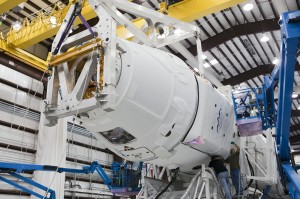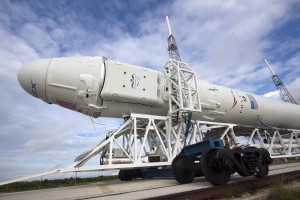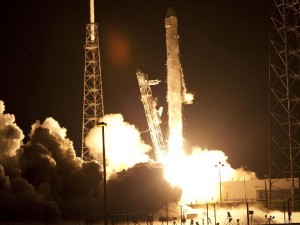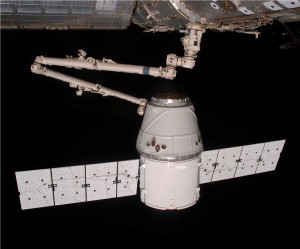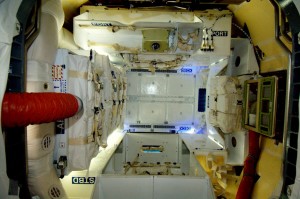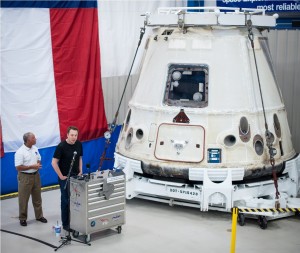The era of private commercial space flight is upon us and all’s looking good in the skies. In collaboration with NASA, SpaceX, the brainchild of inventor and technical guru Elon Musk, made history last May when it completed the first ever docking with the International Space Station by a commercial vehicle. And based on that success, it is ready to embark on the first of 12 contracted flights as a cargo carrier for the United States. Since retiring the space shuttle program last year, the U.S. has been without a delivery system to get supplies and equipment to and from the space station, relying on foreign carriers instead.
Liftoff October 7th
The first resupply mission is scheduled to take off from Cape Canaveral on Sunday, October 7th at 8:35pm (00:35 GMT). The history making flight will be streamed live from NASA’s website beginning at 7:00pm. The unmanned Dragon spacecraft will be launched into space by the SpaceX Falcon 9 rocket, carrying a payload of over 1000 pounds of food, clothing and scientific equipment to service those on board the station. Also aboard will be critical materials to complete and initiate 166 scientific experiments, as well as 23 student experiments, some making a return flight because NASA wasn’t able to perform them on the last flight.
Reusable Vehicles
Unlike previous cargo carriers which burned upon reentry, the Dragon capsule is completely reusable and will be returning with a payload. The cost savings derived from reusability are key for the commercial viability of private space flight. Shortly after takeoff, Falcon 9 will separate from the Dragon and fall to the ocean where it will be retrieved. Once Falcon 9 disengages, the Dragon capsule will activate its solar panels and begin its navigation toward the space station where it is expected to arrive on Wednesday the 10th. Once there, the robotic arm of the space station will capture the Dragon and pull it in for docking. It will stay attached for about three weeks before it detaches and maneuvers itself back to earth for a parachute assisted Pacific Ocean splashdown off the coast of southern California.
NASA Partnership
The nearly four year old partnership between SpaceX and NASA has been a close and comfortable one, with each organization having employees at the other’s base, allowing a constant flow of data from both fronts. The current contract between NASA and SpaceX for cargo transport represents a $1.6 billion deal. SpaceX is one of two companies NASA has contracted with, the other being Orbital Sciences Corp., which is expected to make its initial test flight before the end of the year. NASA has given $396 million to SpaceX and $288 million to Orbital toward the development of their cargo spaceships.
Passenger Flights
In a Google+ Hangout on Friday, Musk said SpaceX is “aiming to do, probably, initially an orbital flight — that just goes to orbit and then returns to Earth with people on board” hopefully in three or four years, and “then to actually take astronauts all the way to the space station in about four years.” That is in line with NASA’s goal of being able to rent seats on a private carrier by 2017. From the beginning, Dragon and Falcon 9 were both designed to transport people, with Dragon capable of transporting seven astronauts to the space station. NASA currently contracts with Russia for transportation aboard their Soyuz craft at a cost approaching $60 million per seat. SpaceX estimates the cost per passenger will be $20 million.
Things are going well these days for 41 year old inventor and entrepreneur Elon Musk. After cofounding PayPal at age 27, he started SpaceX a decade ago. His mission was to reinvent the concept of space transportation as we know it, to include commercial flight and ultimately to allow people to live on other planets.
That improbable business plan by itself would more than fill anybody’s plate, but for Musk, it’s only a part of where his current attention lies. When he’s not spending time with his 1800 employees at SpaceX, he is with his nearly 2100 employees at his other business, Tesla Motors, producer of the innovative Roadster and Model S electric vehicles. In Friday’s Google+ Hangout session with NASA’s Charles Bolden, Musk said he generally splits his time between Tesla and SpaceX, weighing time spent with each as priorities change. We’re guessing this week his priorities are all about rockets.
Would you take a private charter into space? We’ll be booking.











